Power surges can instantly destroy your expensive LED floodlights, causing project delays and budget overruns. A quality Surge Protection Device (SPD) is your first line of defense against this.
A surge protector extends a floodlight’s lifespan by guarding its sensitive internal components, like the driver and LED chips, from damaging voltage spikes. It diverts excess electrical energy safely to the ground, preventing burnout and ensuring the fixture reaches its maximum operational life.
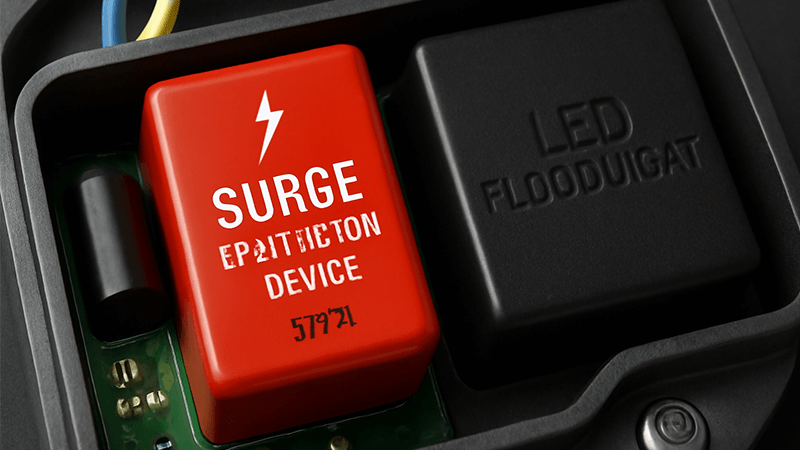
Choosing the right floodlight involves more than just looking at lumens and wattage. As a manufacturer, I’ve seen countless projects where overlooking one small detail—surge protection—led to massive failures down the line. It’s a critical component for reliability, but its effectiveness isn’t always straightforward. Understanding how it works, and its limitations, is key to making a purchasing decision that protects your investment and your reputation. Let’s dive deeper into the questions that purchasing managers like you should be asking.
Do surge protectors have a lifespan?
You install floodlights with surge protection, assuming they are safe forever. But when they fail unexpectedly from a power spike, you realize the protection wasn’t permanent, leaving your investment vulnerable.
Yes, surge protectors have a finite lifespan. They contain components that degrade with every surge they absorb. This lifespan is measured in joules; once the total energy absorbed exceeds this rating, the device no longer offers protection, even if the floodlight itself continues to operate.
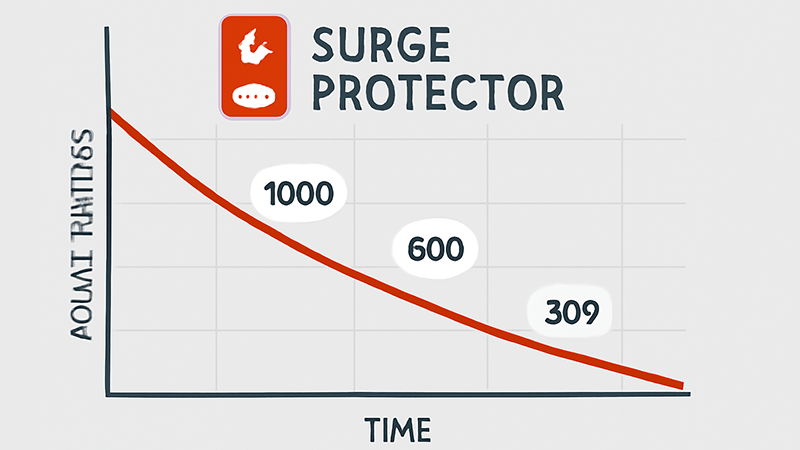
When I started in this industry, I thought of surge protection as a simple on/off feature. It either had it or it didn’t. But experience taught me that the quality and longevity of that protection are what truly matter. The core of most SPDs is a component called a Metal Oxide Varistor, or MOV. Think of it as a gatekeeper for voltage. At normal levels, it does nothing. But when it detects a high-voltage surge, it opens the gate and shunts that dangerous energy to the ground, away from the delicate LED driver.
The key thing to understand is that every time the MOV does this job, it takes a small amount of damage. A big surge will use up a large chunk of its life, while many small, frequent surges will wear it down slowly over time. This is why we measure its capacity in joules. A higher joule rating means it can absorb more total energy before it fails. For a purchasing manager like Shaz in the UAE, who deals with large-scale projects, specifying the right joule rating is essential. An office park with stable power needs a different level of protection than a remote industrial site with an unreliable grid.
| Risk Environment |
Common Surge Events |
Recommended SPD Joule Rating |
| Low Risk |
Stable power grid, rare electrical storms. |
Standard (e.g., 6kV/3kA) |
| Medium Risk |
Occasional grid fluctuations, nearby industrial equipment. |
Enhanced (e.g., 10kV/5kA) |
| High Risk |
Unstable grid, frequent lightning, heavy machinery. |
Robust (e.g., 20kV/10kA) |
Many low-cost floodlights use SPDs with very low joule ratings. They can claim to have "surge protection," but it might fail after just a few minor events, leaving the fixture exposed. This is why, in my factory, we always discuss the application environment with our clients. We match the SPD’s capability to the real-world risk, ensuring the protection lasts.
What are the disadvantages of surge protection devices?
You rely on surge protectors as a perfect solution for fixture longevity. But hidden costs and a finite lifespan can create a false sense of security, leading to unexpected failures and replacements.
The primary disadvantages are the added initial cost, their finite lifespan which necessitates eventual replacement, and the potential for a false sense of security. Relying on an old, depleted SPD provides no real protection, making the fixture vulnerable to the next power surge.
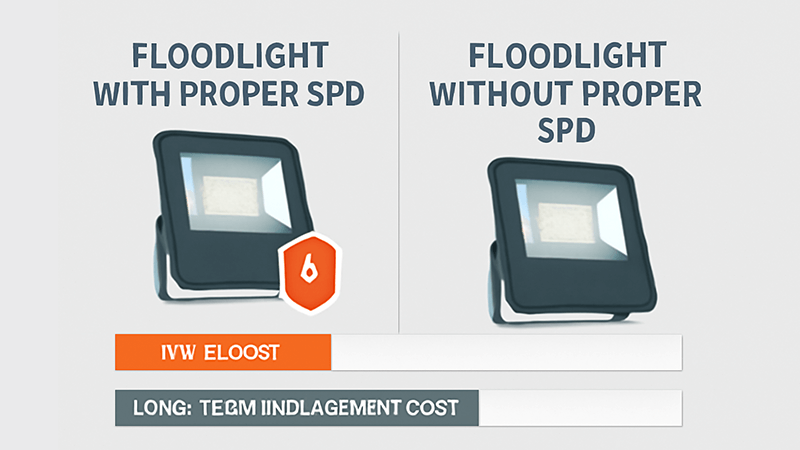
In manufacturing, every component adds to the cost, and SPDs are no exception. A robust, high-joule SPD costs more than a basic one. Some clients are tempted to cut this cost, especially on large orders. I always advise against this. Saving a few dollars on the SPD can risk the entire value of the luminaire, which might cost a hundred times more to replace, not to mention the labor involved. It’s a classic case of being penny-wise and pound-foolish.
Another major disadvantage is that they silently wear out. This creates a dangerous false sense of security. You believe your assets are protected, but the SPD inside could have been depleted months ago. Unless it has a visual indicator light—a feature we build into our higher-spec models—you have no way of knowing it has failed until the floodlight itself is damaged by a surge. From my perspective, we have a responsibility not just to include the component, but to educate our partners on its limitations. A surge protector isn’t a "fit and forget" device.
Here’s how I think about the common disadvantages and our approach to solving them for our partners.
| Disadvantage |
My Manufacturing Perspective & Solution |
| Added Upfront Cost |
I see it as a small insurance premium to protect a much larger investment. We offer tiered protection levels to match the client’s budget and the project’s risk profile. |
| Finite Lifespan |
Quality is key. We source high-grade MOVs with substantial joule ratings to maximize their service life. For critical infrastructure, we strongly recommend SPDs with failure indicators. |
| False Sense of Security |
Education is the antidote. We work closely with our partners to ensure they understand the electrical environment of their projects and the importance of specifying the right level of protection. |
| Physical Size |
A more powerful SPD can sometimes increase the driver housing size. Our design team works to integrate protection efficiently without compromising the luminaire’s form factor or IP rating. |
The disadvantages are real, but they are manageable. They simply highlight the need for a more thoughtful approach to sourcing—one that looks beyond the initial price tag to the total cost of ownership over the product’s entire life.
Do surge protectors lose their effectiveness over time?
Your protected floodlights have worked for years, but now they start failing after storms. The surge protector you trusted seems to have lost its power, leaving you to wonder why it stopped working.
Yes, surge protectors definitively lose effectiveness over time. Every power surge they absorb, no matter how small, causes microscopic degradation of the internal protective components. This cumulative wear reduces its ability to clamp down on overvoltage, until it eventually offers no protection at all.
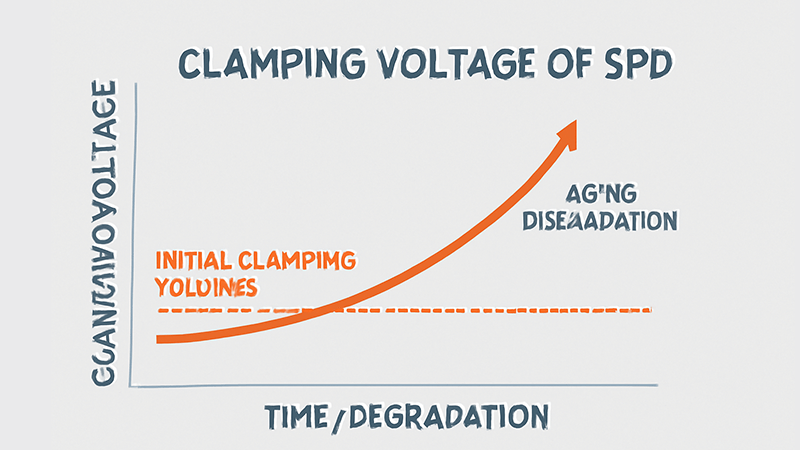
This gradual decay is one of the most misunderstood aspects of surge protection. People often think of it like a fuse that works perfectly until it blows. In reality, it’s more like a car’s tire. It starts with deep, effective treads, but every mile on the road wears them down a little. After 50,000 miles, the tire might still hold air, but it has very little grip left in the rain. An aging SPD is the same. It’s still "there," but its ability to "grip" and divert a surge is severely compromised.
This process happens because the MOV’s internal structure is physically altered by the energy it absorbs. Over time, two things happen. First, its "clamping voltage"—the voltage level at which it activates—can begin to creep up. A new SPD might activate at 400 volts, but an old one might not activate until 600 volts, letting damaging energy pass through to the driver. Second, its total energy absorption capacity (the joule rating) is depleted. Once it’s gone, the next big surge will simply destroy the MOV, and with it, any protection it offered.
In my experience helping clients, this silent degradation is a silent killer of outdoor lighting projects. It aligns with other hidden risks, like the problems caused by poor thermal management. An LED that runs too hot will also degrade and fail prematurely. Just as we use sophisticated heat sinks and thermal pathways to manage heat, we must use high-quality, properly-rated SPDs to manage electrical stress. Both are essential for delivering on the promise of long-life LED lighting. When we design a floodlight, we design a complete system meant to survive in its intended environment. The choice of MOV, its placement, and its rating are just as critical as the choice of LED chip or the design of the heat sink.
How does a surge protector protect against lightning?
A powerful thunderstorm rolls through, and the next day, a section of your new lighting installation is dead. You’re frustrated because you specified surge protection specifically to prevent this from happening.
A standard surge protector does not protect against a direct lightning strike. Instead, it protects against the secondary, induced surges that lightning causes on nearby power lines. It instantly diverts this huge, but brief, overvoltage to the ground, shielding the fixture’s electronics.
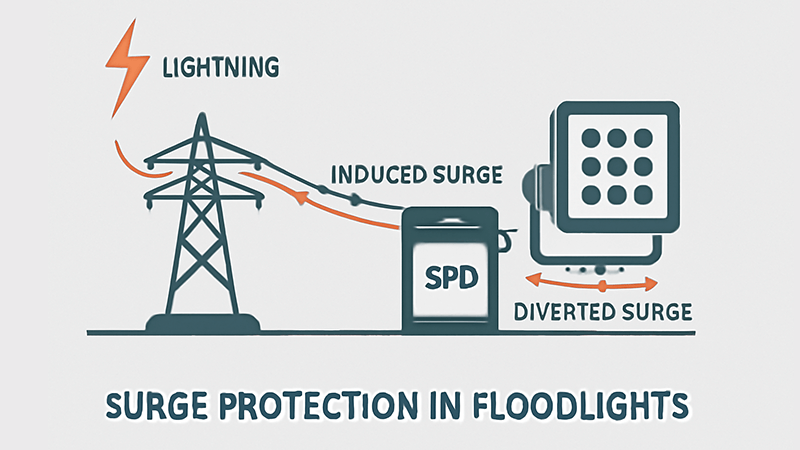
This is the most critical distinction to make. A direct lightning strike can carry millions of volts and hundreds of thousands of amps. No small, fixture-integrated SPD can stop that kind of raw power. Protecting a facility from a direct strike requires a comprehensive lightning protection system (LPS), including air terminals (lightning rods) and heavy-duty grounding—a completely different scope of work.
So what do our floodlight SPDs actually do? They handle the much more common threat: induced surges. When lightning strikes the ground or a power line, even a kilometer away, it creates a massive electromagnetic pulse (EMP). This pulse induces a powerful voltage spike onto any long metal conductors nearby—like the electrical grid that powers your floodlights. This induced surge travels down the wire and into your fixture. While not as powerful as a direct strike, it’s more than enough to fry a sensitive LED driver.
This is where the SPD acts as a traffic diverter. I often use the analogy of a pressure relief valve. Under normal pressure (voltage), the valve is closed. But if a dangerous pressure spike comes along, the valve instantly opens, venting the excess pressure safely. The SPD does the same for electricity. The MOV senses the incoming high voltage, and in nanoseconds, its electrical resistance drops to nearly zero. This creates a short, easy path for the surge current to flow safely to the ground wire, bypassing the rest of the floodlight. Once the surge passes and the voltage returns to normal, the MOV’s resistance goes back to being extremely high, and the fixture continues to operate as if nothing happened.
| Event |
SPD Action |
Floodlight Outcome |
| Normal Operation |
Remains inactive with high resistance. |
Works normally. |
| Indirect Surge (Nearby Lightning) |
Instantly drops resistance, diverts surge to ground. |
Protected. Continues to work normally. |
| Direct Lightning Strike |
The SPD is completely overwhelmed and destroyed. |
Destroyed. Requires a facility-wide LPS for protection. |
Understanding this helps you set the right expectations. An SPD is a vital tool for ensuring reliability against everyday power grid problems and the common effects of lightning, dramatically extending the useful life of your lighting investment.
Conclusion
Surge protection is a critical feature, not an optional extra. It directly extends floodlight lifespan by absorbing electrical surges, but its effectiveness depends entirely on its quality, lifespan, and proper application.